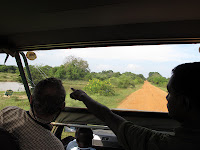Rising early we breakfasted very well, packed up and then had to wait as the driver had not been given his breakfast – finally got off at 8:30 AM. On our way out of town we continued to see the roadside vegetable stands that we saw as we drove into town. Some of the English vegetables Samuel Baker, later Sir Baker, introduced to Nuwara Eliya in the 1840s are popular vegetables throughout the country today. The Baker's Falls at Horton Plains Park are named for him. Initially Samuel Baker was attracted to Sri Lanka because of his love for hunting, specially the hunting of wild elephants (a very destructive sport) which was very popular among the early Englishmen who came to this island. We have found a free ebook of his "Eight Years in Ceylon" which is an account of his life and activities in Ceylon. He is an interesting character whose second wife, he had seen in a slave market in Vidin, Bulgaria, and kidnapped her away from the Sultan's harem, which had outbid him at the auction. Quite an explorer whose other claim to fame is discovering and naming Lake Albert in central Africa.
We saw two places along the road related to the Ramayana folklore. One was the Hindu Temple called "Seetha Kovil" (Hanuman Kovil) is found on the way to Badullar. Folklore says that the mighty demon king Ravana kidnapped princess Seetha who was the queen of Rama and hid her in the place where the temple now is. Later people built a temple in that place on memory of her. Further down the road was a beautiful tall broad waterfall where Ravana and Seetha were to have bathed.
Traveling slowly because of the hills, corners, and slow traffic, it took about four hours to go 180 kilometers, with only one pit stop and a couple of quick stops to view birds we noted along the way. After a lunch, we got into a converted pick-up truck with six seats on an open platform, and drove almost an hour to Yala Park.
 |
| Pheasand-Tailed Jacana walking on lily pads |
 |
| Park has sweet water and salt ocean beach |
Driving on the rough dirt track, along with about 20 similar vehicles, we saw crocodiles, two species of monkeys, wild boar, white-spotted deer, larger Sambar deer, mongooses, wild buffalo, monitor lizards and elephants, but we never saw the Sri Lankan leopards that the Park is famous for. Two cars did see two different leopards just a few hundred meters away from us, and one leopard crossed a road where we had been waiting a minute before – but still no actual leopard seen by us unfortunately. The Sri Lankan leopard (Panthera pardus kotiya) is a leopard subspecies native to Sri Lanka. Classified as endangered the population is believed to be declining due to numerous threats including poaching for trade and human-leopard conflicts. No subpopulation is larger than 250 individuals.
 |
| Tracker pointing out a bird to David |
There was very good bird life in the park, with thousands of Green Bee-Eaters along the path, hundreds of Peacocks, several Malabar Pied Hornbills, two Crested Hawk-Eagles, a Fish Eagle, Brahminy Kites, Green Imperial Pigeons, Orange-breasted Green Pigeons,Blue-Faced Malkoha, Indian Koel, Black Robin, Common Hoopoe, Fantail, Common Iora, large numbers of water birds including Common Kingfishers, Black winged Storks, Painted Storks, Spot-Billed Pelicans, Greater and Lesser Egrets, Crested Herons, Blue Herons, Whistling Ducks, Mallards, Terns, jungle fowl and a number of others that we had seen before.
The park was like a garden of Eden along the sea shore with lovely yellow flowering trees, fresh water ponds and lakes, and large boulders. We wished we had stayed another day so we could have gone to the bird sanctuary that is close by.
 |
| "hunting" for his illusive leopard |
We left the park after dark, reaching our hotel in about an hour, and had a quick buffet dinner, shower, and were off to bed. My step-counter logged that we had done over 5 miles of walking.....really it was registering all the bumps in the road. We had been almost 10 hours in a car today.
 |
| Peacock pruning itself in the trees |




No comments:
Post a Comment